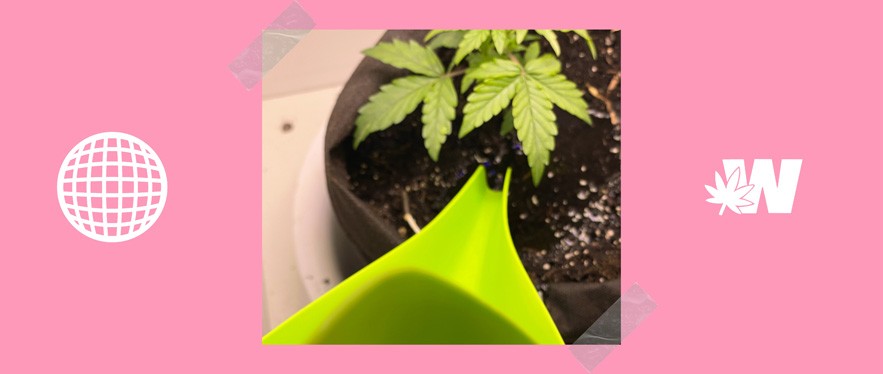Best Cannabis Irrigation System To Ensure Home Grow Success


In the world of cannabis home cultivation, having a reliable and efficient cannabis irrigation system is crucial for success. Proper irrigation plays a vital role in ensuring healthy plant growth, maximizing yields, and maintaining overall plant health. Whether you’re a seasoned grower or just starting out, understanding the importance of irrigation systems can make a significant difference in the quality of your cannabis harvest.
One of the key benefits of using a reliable irrigation system is the ability to provide precise and controlled watering to your plants. Cannabis plants have specific water requirements at different stages of growth, and maintaining optimal moisture levels is essential for their development. A well-designed irrigation system allows you to deliver water directly to the root zone, minimizing waste and reducing the risk of overwatering or underwatering.
Furthermore, an efficient irrigation system can save you time and effort. With automated timers or controllers, you can establish a consistent watering schedule without the need for constant manual intervention. This not only ensures that your plants receive water when they need it most but also allows you to focus on other important aspects of cultivation, such as nutrient management and pest control.
In addition to the practical advantages, a reliable irrigation system can contribute to the overall sustainability of your cannabis cultivation. By using water efficiently and avoiding unnecessary waste, you can minimize your environmental impact and conserve this precious resource. This aspect is particularly important as water scarcity becomes a growing concern in many regions.
As you delve deeper into the world of indoor cannabis cultivation, exploring the various types of irrigation systems available and understanding their benefits will empower you to make informed decisions about the best system for your specific needs. By investing in a high-quality irrigation system, you’ll be setting yourself up for success and maximizing the potential of your home grow. So, let’s dive in and discover the best cannabis irrigation systems that will ensure your home grow thrives.
Understanding Cannabis Irrigation Needs
Cannabis plants have specific water requirements that vary throughout their different growth stages. Understanding these needs is crucial for providing optimal care and ensuring the health and productivity of your plants. Let’s explore the water requirements at each stage and emphasize the importance of maintaining proper moisture levels.
Seedling Stage
During the seedling stage, marijuana plants are fragile and delicate. They require a consistently moist but not overly wet environment. Overwatering can lead to root rot and other diseases, while underwatering can stunt growth and cause wilting. It’s essential to strike a balance by providing a gentle misting or light watering to keep the growing cannabis soil medium moist.
Vegetative Stage
In the vegetative stage, cannabis plants experience rapid growth and development. They require more water as their root systems expand. It’s important to ensure that the growing medium remains consistently moist but not waterlogged. Allowing the top layer of soil to dry slightly between waterings promotes healthy root development and prevents issues like root rot.
Flowering Stage
During the flowering stage, cannabis plants focus their energy on bud formation. At this stage, it’s crucial to maintain proper moisture levels to support the development of dense, resinous flowers. However, it’s equally important not to water plants excessively, as it can lead to bud rot and mold. It’s recommended to water deeply but infrequently, allowing the top layer of soil to dry out before the next watering.
Late Flowering and Harvest
In the late flowering stage, cannabis plants undergo the final maturation process, and it’s important to adjust the watering accordingly. Gradually reducing the amount of water given to the plants during this period helps to optimize resin production and enhance the flavor and potency of the buds. This technique, known as “flushing,” helps remove any residual nutrients and improves the overall quality of the final harvest.
Maintaining proper moisture levels throughout the growth stages is essential for healthy cannabis plants. Overwatering can lead to oxygen deprivation in the root zone, nutrient deficiencies, and the proliferation of pathogens. Underwatering, on the other hand, can result in stress, nutrient lockout, and stunted growth. Striking the right balance ensures that the plants can uptake nutrients efficiently, promotes robust root development, and minimizes the risk of diseases.
By monitoring the moisture levels of the growing medium, observing the plant’s overall health, and adjusting your watering practices accordingly, you can meet the specific water requirements of cannabis plants at each growth stage. This attentiveness to irrigation will contribute to the overall success of your home cultivation journey.
Types of Cannabis Irrigation Systems
Drip Irrigation Systems
Drip irrigation systems are a popular choice for cannabis cultivation due to their efficiency and precision. These systems work by delivering water directly to the base of the plants through a network of tubes or emitters. So, how does a drip irrigation system work?
The drip system utilizes a main water supply line connected to individual drippers or emitters strategically placed near each plant. Water flows through an emitter at a controlled rate, ensuring a slow and steady supply directly to the root zone.
Drip irrigation offers several benefits, including water conservation, reduced risk of overwatering, and precise nutrient delivery. It also minimizes water evaporation and weed growth. However, some drawbacks include the initial cost of setup, the potential for clogged emitters, and the need for regular maintenance.
Automated Sprinkler Systems
Automated sprinkler systems are another viable option for cannabis irrigation, offering convenience and coverage for larger grow areas. These systems consist of a network of sprinkler heads strategically positioned to distribute water over the plants. They are connected to a timer or controller that regulates the frequency and duration of watering cycles.
Automated sprinkler systems offer efficient coverage, time-saving automation, and versatility in adjusting spray patterns. However, they may not provide the same precision as drip systems, leading to potential water waste and increased humidity levels that could encourage mold and mildew.
Ebb and Flow Irrigation
Ebb and flow, or flood and drain systems, provide a dynamic approach to cannabis irrigation. Ebb and flow systems involve periodically flooding the grow medium with nutrient-rich water and then allowing it to drain away. This process ensures that plants receive ample water and nutrients while preventing waterlogging.
Ebb and flow systems provide excellent oxygenation to the roots, promote robust growth, and offer easy nutrient management. However, they require careful monitoring to avoid flooding and can be challenging to set up for novice growers.
Aeroponic Systems
Aeroponic systems are a cutting-edge option for cannabis cultivation, utilizing misting or fogging to deliver water and nutrients directly to the roots. Aeroponic systems suspend the plant’s root zone in air and mist it with a nutrient solution. This method allows for efficient nutrient uptake and optimal oxygenation of the roots.
Aeroponic systems offer rapid growth, maximum nutrient absorption, and reduced water usage. However, they require precise control of environmental conditions, regular monitoring, and a higher level of expertise to ensure success.
Hand Watering
Finally, hand watering is the simplest irrigation method, it involves manually watering the plants with a watering can or hose. This method can be useful for small home grows or for plants that are particularly sensitive to water quality. Hand watering allows growers to monitor the plants more closely and detect any problems early on. One of the main disadvantages of this method is, it can be very time-consuming and require daily attention.
Factors to Consider When Choosing an Irrigation System
When selecting an irrigation system for your cannabis cultivation, it’s essential to consider various factors to ensure the system aligns with your specific needs. Here are the key factors to consider:
Grow Space Size
The size of your grow space plays a vital role in determining the type of irrigation system that will work best for you. Smaller spaces may benefit from drip irrigation or aeroponic systems, while larger areas may require automated sprinkler systems or ebb and flow systems. Consider the layout and dimensions of your grow space to determine the most suitable irrigation system.
Budget
Your budget is another critical factor in choosing an irrigation system. Different systems come with varying costs, including installation expenses, equipment, and ongoing maintenance. Determine your budget and explore options that offer the best value for your investment. Consider both upfront costs and long-term savings in terms of water efficiency and plant health.
Water Source Availability
The availability and quality of your water source are crucial considerations. Determine if you have access to a reliable water supply, whether from municipal sources or alternative water collection methods. Additionally, consider the water quality and whether it requires additional filtration or treatment before use in the irrigation system. Some systems may have specific requirements for water quality, so factor this into your decision-making process.
Level of Automation
Consider the level of automation you desire for your irrigation system. Automated systems, such as timers or controllers, provide convenience by automatically managing watering schedules. These systems can be particularly beneficial if you have a busy schedule or need to be away from your grow space for extended periods. Alternatively, manual systems require more hands-on management but may offer more control and flexibility in adjusting watering patterns.
Ease of Installation and Maintenance
Evaluate the ease of installation and ongoing maintenance requirements of the irrigation system. Some systems, like drip irrigation or aeroponic systems, may require more initial setup and ongoing monitoring. On the other hand, automated sprinkler systems or ebb and flow systems might be relatively easier to install and maintain. Consider your level of expertise and the time you can dedicate to installation and regular maintenance to choose a system that fits your capabilities.
By carefully considering these factors — grow space size, budget, water source availability, level of automation, and ease of installation and maintenance — you can select an irrigation system that meets your specific requirements. This thoughtful selection process will contribute to the success of your cannabis cultivation and help ensure optimal water management and plant health.
Tips for Successful Cannabis Irrigation
To ensure successful cannabis home cultivation, it’s important to implement proper irrigation practices. Here are some essential tips to keep in mind:
- Monitoring and Adjusting pH Levels. Regularly monitor and adjust the pH levels of your irrigation water. Cannabis plants thrive in a slightly acidic environment, with a pH range of 5.5 to 6.5. Maintaining the correct pH ensures optimal nutrient uptake and prevents nutrient deficiencies or toxicities.
- Avoiding Overwatering and Underwatering. Finding the right balance in watering is crucial. Overwatering can lead to root rot and other diseases, while underwatering can cause stunted growth. Pay attention to your plants’ water requirements at different growth stages and adjust watering frequency accordingly.
- Implementing a Timer or Controller System. Using a timer or controller system for your irrigation setup provides consistency and convenience. Set up a watering schedule based on your plants’ needs, taking into account factors like growth stage, environmental conditions, and water requirements. This ensures regular and timely watering, even when you’re away.
- Regularly Inspecting and Cleaning Irrigation Components. Perform routine inspections of your irrigation system to check for clogs, leaks, or damaged components. Clean or replace clogged emitters or nozzles, and ensure proper water flow throughout the system. This helps maintain efficient water distribution and prevents potential problems.
- Using Filters and Water Conditioners. Incorporate filters and water conditioners into your irrigation system to prevent clogging caused by debris or mineral buildup. Filters remove sediment and impurities, while water conditioners help address issues like hard water or high chlorine content, which can negatively impact plant health.
Conclusion
In conclusion, choosing the right irrigation system is vital for successful cannabis home cultivation. Consider factors such as grow space size, budget, water source availability, level of automation, and ease of installation and maintenance when selecting an irrigation system.
Throughout the cultivation process, it’s crucial to monitor and adjust pH levels, avoid overwatering and underwatering, implement timer or controller systems, regularly inspect and clean irrigation components, and use filters and water conditioners. These practices contribute to optimal plant health, water efficiency, and overall success in your cannabis cultivation endeavors.
By implementing these tips and selecting the appropriate irrigation system, you can ensure that your cannabis plants receive the proper amount of water, nutrients, and care they need, leading to healthy growth, abundant yields, and a satisfying home cultivation experience.
















